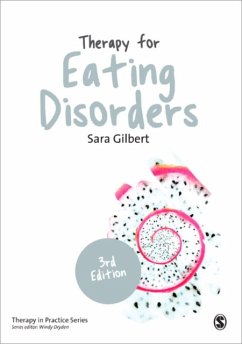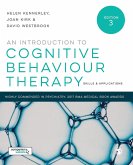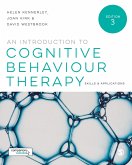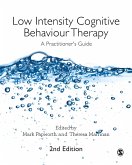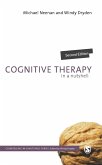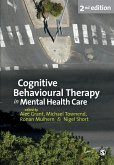- Broschiertes Buch
- Merkliste
- Auf die Merkliste
- Bewerten Bewerten
- Teilen
- Produkt teilen
- Produkterinnerung
- Produkterinnerung
This updated edition provides an excellent overview of the diagnosis, prevalence and causes of eating disorders, as well as a handbook for the application of evidence based interventions. A must buy for eating disorder services and individual practitioners!
Sally Savage, Clinical Lead for Northamptonshire NHS Eating Disorders Lifespan Service
Affecting thousands of people every year with potentially devastating consequences, anorexia, bulimia and binge eating disorders are becoming increasingly evident in today s fast paced, high pressured society.
Drawing on over 20 years experience…mehr
Andere Kunden interessierten sich auch für
![An Introduction to Cognitive Behaviour Therapy An Introduction to Cognitive Behaviour Therapy]() Helen KennerleyAn Introduction to Cognitive Behaviour Therapy30,99 €
Helen KennerleyAn Introduction to Cognitive Behaviour Therapy30,99 €![An Introduction to Cognitive Behaviour Therapy An Introduction to Cognitive Behaviour Therapy]() Helen KennerleyAn Introduction to Cognitive Behaviour Therapy101,99 €
Helen KennerleyAn Introduction to Cognitive Behaviour Therapy101,99 €![Low Intensity Cognitive Behaviour Therapy Low Intensity Cognitive Behaviour Therapy]() Low Intensity Cognitive Behaviour Therapy102,99 €
Low Intensity Cognitive Behaviour Therapy102,99 €![Cognitive Therapy in a Nutshell Cognitive Therapy in a Nutshell]() Michael NeenanCognitive Therapy in a Nutshell24,99 €
Michael NeenanCognitive Therapy in a Nutshell24,99 €![Cognitive Behavioural Therapy in Mental Health Care Cognitive Behavioural Therapy in Mental Health Care]() Alec GrantCognitive Behavioural Therapy in Mental Health Care39,99 €
Alec GrantCognitive Behavioural Therapy in Mental Health Care39,99 €![Art Therapy Art Therapy]() David EdwardsArt Therapy35,99 €
David EdwardsArt Therapy35,99 €![CBT with Children, Young People and Families CBT with Children, Young People and Families]() Peter FuggleCBT with Children, Young People and Families38,99 €
Peter FuggleCBT with Children, Young People and Families38,99 €-
-
-
This updated edition provides an excellent overview of the diagnosis, prevalence and causes of eating disorders, as well as a handbook for the application of evidence based interventions. A must buy for eating disorder services and individual practitioners!
Sally Savage, Clinical Lead for Northamptonshire NHS Eating Disorders Lifespan Service
Affecting thousands of people every year with potentially devastating consequences, anorexia, bulimia and binge eating disorders are becoming increasingly evident in today s fast paced, high pressured society.
Drawing on over 20 years experience as a practitioner, Sara Gilbert takes the reader through the complexities of working with eating disorders, drawing on practical, cognitive behavioural and educational approaches to theory, assessment, treatment and practice. Packed full of new resources for both qualified professionals and trainees, this new edition includes:
· A summary of new research on the causes of eating disorders, dual diagnosis and co-morbidity.
· New content on the best treatment for eating disorders and preparing clients for treatment.
· An updated chapter examining the effects of nutrition on physical and psychological well-being.
· New content on working with complexity and risk.
· A fully updated reference section.
This is a vital resource for practitioners in the mental health field, including psychotherapists, psychologists, counsellors, psychiatrists, mental health nurses and dieticians.
Sara Gilbert is a chartered clinical psychologist whose specialist interest in the field of eating disorders spans 20 years. She has worked for 12 years as a clinical lead in an eating disorder service in the NHS and is now in private practice.
Sally Savage, Clinical Lead for Northamptonshire NHS Eating Disorders Lifespan Service
Affecting thousands of people every year with potentially devastating consequences, anorexia, bulimia and binge eating disorders are becoming increasingly evident in today s fast paced, high pressured society.
Drawing on over 20 years experience as a practitioner, Sara Gilbert takes the reader through the complexities of working with eating disorders, drawing on practical, cognitive behavioural and educational approaches to theory, assessment, treatment and practice. Packed full of new resources for both qualified professionals and trainees, this new edition includes:
· A summary of new research on the causes of eating disorders, dual diagnosis and co-morbidity.
· New content on the best treatment for eating disorders and preparing clients for treatment.
· An updated chapter examining the effects of nutrition on physical and psychological well-being.
· New content on working with complexity and risk.
· A fully updated reference section.
This is a vital resource for practitioners in the mental health field, including psychotherapists, psychologists, counsellors, psychiatrists, mental health nurses and dieticians.
Sara Gilbert is a chartered clinical psychologist whose specialist interest in the field of eating disorders spans 20 years. She has worked for 12 years as a clinical lead in an eating disorder service in the NHS and is now in private practice.
Produktdetails
- Produktdetails
- Therapy in Practice
- Verlag: SAGE Publications Ltd / Sage Publications
- 3. Aufl.
- Seitenzahl: 266
- Erscheinungstermin: 16. Dezember 2013
- Englisch
- Abmessung: 244mm x 170mm x 14mm
- Gewicht: 460g
- ISBN-13: 9781446240953
- ISBN-10: 1446240959
- Artikelnr.: 39253357
- Herstellerkennzeichnung
- Libri GmbH
- Europaallee 1
- 36244 Bad Hersfeld
- gpsr@libri.de
- Therapy in Practice
- Verlag: SAGE Publications Ltd / Sage Publications
- 3. Aufl.
- Seitenzahl: 266
- Erscheinungstermin: 16. Dezember 2013
- Englisch
- Abmessung: 244mm x 170mm x 14mm
- Gewicht: 460g
- ISBN-13: 9781446240953
- ISBN-10: 1446240959
- Artikelnr.: 39253357
- Herstellerkennzeichnung
- Libri GmbH
- Europaallee 1
- 36244 Bad Hersfeld
- gpsr@libri.de
Sara Gilbert is a chartered clinical psychologist who has had a specialist interest in the field of eating disorders for nearly twenty years. She currently works for the Luton and Bedfordshire community NHS trust.
Preface
Acknowledgements
What is an eating disorder?
A note about psychiatric diagnosis
Eating Disorders in the twenty first century
The relationship between weight and eating disorder
Anorexia nervosa
Bulimia nervosa
Binge Eating Disorder
Feeding and Eating disorders not elsewhere classified
Other causes of weight loss or gain or unusual eating behaviours
Causes of the Eating Disorders
Psychobiological mechanisms
Psychosomatic theories
Looking for an explanation in the past
Eating disorder and other psychiatric diagnoses: is there a genetic susceptibility?
Anorexia and bulimia nervosa as sociocultural phenomena
Eating disorder as learned behavior
Eating disorder as a corollary to dieting and food deprivation
Conclusions
Treatment for the Eating Disorders
Psychodynamic therapies
Family therapies
The use of psychotropic medication
Cognitive behaviour therapy
An outline of the characteristics of CBT
How effective is CBT for eating disorders?
Conclusions
A Cognitive Behavioural and Integrative Approach to Eating Disorders
The theoretical basis of a cognitive behaviour therapy approach to the eating disorders
The structure of cognitive therapy for eating disorders
The acceptability of cognitive therapy for eating disorders
A broad interpretation of cognitive therapy for the eating disorders
Conclusions
Beginning the Therapy Process
The initial stages
Some questions to ask when assessing the person with an eating disorder
The use of questionnaires in the assessment of eating disorder
Is this the right time for therapy?
Conclusion
Preparing for change
Presenting the cognitive behavioural view and formulating the problem
Assessment of motivational stage in people with an eating disorder
Self-monitoring by the client
Setting the agenda for therapy
A focus on emotions and coping strategies
Psychoeducation
Nutritional Aspects of Helping the Eating-Disordered Client
Nutritional knowledge of eating-disordered clients
Nutritional counselling
The body's need for good nutrition
Knowledge about energy balance and weight regulation
Information about the specific effects of bingeing and purging
Information about the effects of food and eating on metabolism
Establishing a normal eating pattern with obese binge eaters: to diet or not?
Establishing weight gain with anorexics
Behavioural Techniques
Self-monitoring
Target setting
Behavioural experiments
Self-reward
Scheduling pleasant events
Behavioural techniques for controlling overeating (self-control)
Taking exercise
Practising 'normal' eating
Exposure
Assertiveness around food
Relaxation and stress management
Conclusion
Cognitive Techniques
Identifying negative thoughts
Answering negative thoughts
Homework
Identifying and dealing with dysfunctional assumptions and core beliefs
Modifying assumptions and core beliefs
Exploring the meaning of eating disorder symptoms
Getting 'stuck'
Conclusion
Adapting to Different Situations and Dealing with Endings
Working with severe and complex cases
The end of the therapy relationship
Preventing relapse
Involving family members in the therapy process
Working with groups
Working in parallel with other treatments
Conclusion
Conclusion
Appendix 1: Some useful web pages
Appendix 2: Eating Problems: Resources for Clients
Appendix 3: Eating Disorders and their Effects
Appendix 4: Guidelines for Normal Healthy Eating
Appendix 5: The Effects of Strict Dieting and Starvation and of Giving Them Up
Appendix 6: Medical and Physical Problems Caused by the Symptoms of Eating Disorders
Appendix 7: Controlling What You Eat
Appendix 8: Giving Up Vomiting as a Way to Control Your Weight or Deal with Stress
Appendix 9: Learning to be Assertive about What You Eat: A Bill of Rights
References
Index
Acknowledgements
What is an eating disorder?
A note about psychiatric diagnosis
Eating Disorders in the twenty first century
The relationship between weight and eating disorder
Anorexia nervosa
Bulimia nervosa
Binge Eating Disorder
Feeding and Eating disorders not elsewhere classified
Other causes of weight loss or gain or unusual eating behaviours
Causes of the Eating Disorders
Psychobiological mechanisms
Psychosomatic theories
Looking for an explanation in the past
Eating disorder and other psychiatric diagnoses: is there a genetic susceptibility?
Anorexia and bulimia nervosa as sociocultural phenomena
Eating disorder as learned behavior
Eating disorder as a corollary to dieting and food deprivation
Conclusions
Treatment for the Eating Disorders
Psychodynamic therapies
Family therapies
The use of psychotropic medication
Cognitive behaviour therapy
An outline of the characteristics of CBT
How effective is CBT for eating disorders?
Conclusions
A Cognitive Behavioural and Integrative Approach to Eating Disorders
The theoretical basis of a cognitive behaviour therapy approach to the eating disorders
The structure of cognitive therapy for eating disorders
The acceptability of cognitive therapy for eating disorders
A broad interpretation of cognitive therapy for the eating disorders
Conclusions
Beginning the Therapy Process
The initial stages
Some questions to ask when assessing the person with an eating disorder
The use of questionnaires in the assessment of eating disorder
Is this the right time for therapy?
Conclusion
Preparing for change
Presenting the cognitive behavioural view and formulating the problem
Assessment of motivational stage in people with an eating disorder
Self-monitoring by the client
Setting the agenda for therapy
A focus on emotions and coping strategies
Psychoeducation
Nutritional Aspects of Helping the Eating-Disordered Client
Nutritional knowledge of eating-disordered clients
Nutritional counselling
The body's need for good nutrition
Knowledge about energy balance and weight regulation
Information about the specific effects of bingeing and purging
Information about the effects of food and eating on metabolism
Establishing a normal eating pattern with obese binge eaters: to diet or not?
Establishing weight gain with anorexics
Behavioural Techniques
Self-monitoring
Target setting
Behavioural experiments
Self-reward
Scheduling pleasant events
Behavioural techniques for controlling overeating (self-control)
Taking exercise
Practising 'normal' eating
Exposure
Assertiveness around food
Relaxation and stress management
Conclusion
Cognitive Techniques
Identifying negative thoughts
Answering negative thoughts
Homework
Identifying and dealing with dysfunctional assumptions and core beliefs
Modifying assumptions and core beliefs
Exploring the meaning of eating disorder symptoms
Getting 'stuck'
Conclusion
Adapting to Different Situations and Dealing with Endings
Working with severe and complex cases
The end of the therapy relationship
Preventing relapse
Involving family members in the therapy process
Working with groups
Working in parallel with other treatments
Conclusion
Conclusion
Appendix 1: Some useful web pages
Appendix 2: Eating Problems: Resources for Clients
Appendix 3: Eating Disorders and their Effects
Appendix 4: Guidelines for Normal Healthy Eating
Appendix 5: The Effects of Strict Dieting and Starvation and of Giving Them Up
Appendix 6: Medical and Physical Problems Caused by the Symptoms of Eating Disorders
Appendix 7: Controlling What You Eat
Appendix 8: Giving Up Vomiting as a Way to Control Your Weight or Deal with Stress
Appendix 9: Learning to be Assertive about What You Eat: A Bill of Rights
References
Index
Preface Acknowledgements What is an eating disorder? A note about psychiatric diagnosis Eating Disorders in the twenty first century The relationship between weight and eating disorder Anorexia nervosa Bulimia nervosa Binge Eating Disorder Feeding and Eating disorders not elsewhere classified Other causes of weight loss or gain or unusual eating behaviours Causes of the Eating Disorders Psychobiological mechanisms Psychosomatic theories Looking for an explanation in the past Eating disorder and other psychiatric diagnoses: is there a genetic susceptibility? Anorexia and bulimia nervosa as sociocultural phenomena Eating disorder as learned behavior Eating disorder as a corollary to dieting and food deprivation Conclusions Treatment for the Eating Disorders Psychodynamic therapies Family therapies The use of psychotropic medication Cognitive behaviour therapy An outline of the characteristics of CBT How effective is CBT for eating disorders? Conclusions A Cognitive Behavioural and Integrative Approach to Eating Disorders The theoretical basis of a cognitive behaviour therapy approach to the eating disorders The structure of cognitive therapy for eating disorders The acceptability of cognitive therapy for eating disorders A broad interpretation of cognitive therapy for the eating disorders Conclusions Beginning the Therapy Process The initial stages Some questions to ask when assessing the person with an eating disorder The use of questionnaires in the assessment of eating disorder Is this the right time for therapy? Conclusion Preparing for change Presenting the cognitive behavioural view and formulating the problem Assessment of motivational stage in people with an eating disorder Self-monitoring by the client Setting the agenda for therapy A focus on emotions and coping strategies Psychoeducation Nutritional Aspects of Helping the Eating-Disordered Client Nutritional knowledge of eating-disordered clients Nutritional counselling The body
s need for good nutrition Knowledge about energy balance and weight regulation Information about the specific effects of bingeing and purging Information about the effects of food and eating on metabolism Establishing a normal eating pattern with obese binge eaters: to diet or not? Establishing weight gain with anorexics Behavioural Techniques Self-monitoring Target setting Behavioural experiments Self-reward Scheduling pleasant events Behavioural techniques for controlling overeating (self-control) Taking exercise Practising
normal
eating Exposure Assertiveness around food Relaxation and stress management Conclusion Cognitive Techniques Identifying negative thoughts Answering negative thoughts Homework Identifying and dealing with dysfunctional assumptions and core beliefs Modifying assumptions and core beliefs Exploring the meaning of eating disorder symptoms Getting
stuck
Conclusion Adapting to Different Situations and Dealing with Endings Working with severe and complex cases The end of the therapy relationship Preventing relapse Involving family members in the therapy process Working with groups Working in parallel with other treatments Conclusion Conclusion Appendix 1: Some useful web pages Appendix 2: Eating Problems: Resources for Clients Appendix 3: Eating Disorders and their Effects Appendix 4: Guidelines for Normal Healthy Eating Appendix 5: The Effects of Strict Dieting and Starvation and of Giving Them Up Appendix 6: Medical and Physical Problems Caused by the Symptoms of Eating Disorders Appendix 7: Controlling What You Eat Appendix 8: Giving Up Vomiting as a Way to Control Your Weight or Deal with Stress Appendix 9: Learning to be Assertive about What You Eat: A Bill of Rights References Index
s need for good nutrition Knowledge about energy balance and weight regulation Information about the specific effects of bingeing and purging Information about the effects of food and eating on metabolism Establishing a normal eating pattern with obese binge eaters: to diet or not? Establishing weight gain with anorexics Behavioural Techniques Self-monitoring Target setting Behavioural experiments Self-reward Scheduling pleasant events Behavioural techniques for controlling overeating (self-control) Taking exercise Practising
normal
eating Exposure Assertiveness around food Relaxation and stress management Conclusion Cognitive Techniques Identifying negative thoughts Answering negative thoughts Homework Identifying and dealing with dysfunctional assumptions and core beliefs Modifying assumptions and core beliefs Exploring the meaning of eating disorder symptoms Getting
stuck
Conclusion Adapting to Different Situations and Dealing with Endings Working with severe and complex cases The end of the therapy relationship Preventing relapse Involving family members in the therapy process Working with groups Working in parallel with other treatments Conclusion Conclusion Appendix 1: Some useful web pages Appendix 2: Eating Problems: Resources for Clients Appendix 3: Eating Disorders and their Effects Appendix 4: Guidelines for Normal Healthy Eating Appendix 5: The Effects of Strict Dieting and Starvation and of Giving Them Up Appendix 6: Medical and Physical Problems Caused by the Symptoms of Eating Disorders Appendix 7: Controlling What You Eat Appendix 8: Giving Up Vomiting as a Way to Control Your Weight or Deal with Stress Appendix 9: Learning to be Assertive about What You Eat: A Bill of Rights References Index
Preface
Acknowledgements
What is an eating disorder?
A note about psychiatric diagnosis
Eating Disorders in the twenty first century
The relationship between weight and eating disorder
Anorexia nervosa
Bulimia nervosa
Binge Eating Disorder
Feeding and Eating disorders not elsewhere classified
Other causes of weight loss or gain or unusual eating behaviours
Causes of the Eating Disorders
Psychobiological mechanisms
Psychosomatic theories
Looking for an explanation in the past
Eating disorder and other psychiatric diagnoses: is there a genetic susceptibility?
Anorexia and bulimia nervosa as sociocultural phenomena
Eating disorder as learned behavior
Eating disorder as a corollary to dieting and food deprivation
Conclusions
Treatment for the Eating Disorders
Psychodynamic therapies
Family therapies
The use of psychotropic medication
Cognitive behaviour therapy
An outline of the characteristics of CBT
How effective is CBT for eating disorders?
Conclusions
A Cognitive Behavioural and Integrative Approach to Eating Disorders
The theoretical basis of a cognitive behaviour therapy approach to the eating disorders
The structure of cognitive therapy for eating disorders
The acceptability of cognitive therapy for eating disorders
A broad interpretation of cognitive therapy for the eating disorders
Conclusions
Beginning the Therapy Process
The initial stages
Some questions to ask when assessing the person with an eating disorder
The use of questionnaires in the assessment of eating disorder
Is this the right time for therapy?
Conclusion
Preparing for change
Presenting the cognitive behavioural view and formulating the problem
Assessment of motivational stage in people with an eating disorder
Self-monitoring by the client
Setting the agenda for therapy
A focus on emotions and coping strategies
Psychoeducation
Nutritional Aspects of Helping the Eating-Disordered Client
Nutritional knowledge of eating-disordered clients
Nutritional counselling
The body's need for good nutrition
Knowledge about energy balance and weight regulation
Information about the specific effects of bingeing and purging
Information about the effects of food and eating on metabolism
Establishing a normal eating pattern with obese binge eaters: to diet or not?
Establishing weight gain with anorexics
Behavioural Techniques
Self-monitoring
Target setting
Behavioural experiments
Self-reward
Scheduling pleasant events
Behavioural techniques for controlling overeating (self-control)
Taking exercise
Practising 'normal' eating
Exposure
Assertiveness around food
Relaxation and stress management
Conclusion
Cognitive Techniques
Identifying negative thoughts
Answering negative thoughts
Homework
Identifying and dealing with dysfunctional assumptions and core beliefs
Modifying assumptions and core beliefs
Exploring the meaning of eating disorder symptoms
Getting 'stuck'
Conclusion
Adapting to Different Situations and Dealing with Endings
Working with severe and complex cases
The end of the therapy relationship
Preventing relapse
Involving family members in the therapy process
Working with groups
Working in parallel with other treatments
Conclusion
Conclusion
Appendix 1: Some useful web pages
Appendix 2: Eating Problems: Resources for Clients
Appendix 3: Eating Disorders and their Effects
Appendix 4: Guidelines for Normal Healthy Eating
Appendix 5: The Effects of Strict Dieting and Starvation and of Giving Them Up
Appendix 6: Medical and Physical Problems Caused by the Symptoms of Eating Disorders
Appendix 7: Controlling What You Eat
Appendix 8: Giving Up Vomiting as a Way to Control Your Weight or Deal with Stress
Appendix 9: Learning to be Assertive about What You Eat: A Bill of Rights
References
Index
Acknowledgements
What is an eating disorder?
A note about psychiatric diagnosis
Eating Disorders in the twenty first century
The relationship between weight and eating disorder
Anorexia nervosa
Bulimia nervosa
Binge Eating Disorder
Feeding and Eating disorders not elsewhere classified
Other causes of weight loss or gain or unusual eating behaviours
Causes of the Eating Disorders
Psychobiological mechanisms
Psychosomatic theories
Looking for an explanation in the past
Eating disorder and other psychiatric diagnoses: is there a genetic susceptibility?
Anorexia and bulimia nervosa as sociocultural phenomena
Eating disorder as learned behavior
Eating disorder as a corollary to dieting and food deprivation
Conclusions
Treatment for the Eating Disorders
Psychodynamic therapies
Family therapies
The use of psychotropic medication
Cognitive behaviour therapy
An outline of the characteristics of CBT
How effective is CBT for eating disorders?
Conclusions
A Cognitive Behavioural and Integrative Approach to Eating Disorders
The theoretical basis of a cognitive behaviour therapy approach to the eating disorders
The structure of cognitive therapy for eating disorders
The acceptability of cognitive therapy for eating disorders
A broad interpretation of cognitive therapy for the eating disorders
Conclusions
Beginning the Therapy Process
The initial stages
Some questions to ask when assessing the person with an eating disorder
The use of questionnaires in the assessment of eating disorder
Is this the right time for therapy?
Conclusion
Preparing for change
Presenting the cognitive behavioural view and formulating the problem
Assessment of motivational stage in people with an eating disorder
Self-monitoring by the client
Setting the agenda for therapy
A focus on emotions and coping strategies
Psychoeducation
Nutritional Aspects of Helping the Eating-Disordered Client
Nutritional knowledge of eating-disordered clients
Nutritional counselling
The body's need for good nutrition
Knowledge about energy balance and weight regulation
Information about the specific effects of bingeing and purging
Information about the effects of food and eating on metabolism
Establishing a normal eating pattern with obese binge eaters: to diet or not?
Establishing weight gain with anorexics
Behavioural Techniques
Self-monitoring
Target setting
Behavioural experiments
Self-reward
Scheduling pleasant events
Behavioural techniques for controlling overeating (self-control)
Taking exercise
Practising 'normal' eating
Exposure
Assertiveness around food
Relaxation and stress management
Conclusion
Cognitive Techniques
Identifying negative thoughts
Answering negative thoughts
Homework
Identifying and dealing with dysfunctional assumptions and core beliefs
Modifying assumptions and core beliefs
Exploring the meaning of eating disorder symptoms
Getting 'stuck'
Conclusion
Adapting to Different Situations and Dealing with Endings
Working with severe and complex cases
The end of the therapy relationship
Preventing relapse
Involving family members in the therapy process
Working with groups
Working in parallel with other treatments
Conclusion
Conclusion
Appendix 1: Some useful web pages
Appendix 2: Eating Problems: Resources for Clients
Appendix 3: Eating Disorders and their Effects
Appendix 4: Guidelines for Normal Healthy Eating
Appendix 5: The Effects of Strict Dieting and Starvation and of Giving Them Up
Appendix 6: Medical and Physical Problems Caused by the Symptoms of Eating Disorders
Appendix 7: Controlling What You Eat
Appendix 8: Giving Up Vomiting as a Way to Control Your Weight or Deal with Stress
Appendix 9: Learning to be Assertive about What You Eat: A Bill of Rights
References
Index
Preface Acknowledgements What is an eating disorder? A note about psychiatric diagnosis Eating Disorders in the twenty first century The relationship between weight and eating disorder Anorexia nervosa Bulimia nervosa Binge Eating Disorder Feeding and Eating disorders not elsewhere classified Other causes of weight loss or gain or unusual eating behaviours Causes of the Eating Disorders Psychobiological mechanisms Psychosomatic theories Looking for an explanation in the past Eating disorder and other psychiatric diagnoses: is there a genetic susceptibility? Anorexia and bulimia nervosa as sociocultural phenomena Eating disorder as learned behavior Eating disorder as a corollary to dieting and food deprivation Conclusions Treatment for the Eating Disorders Psychodynamic therapies Family therapies The use of psychotropic medication Cognitive behaviour therapy An outline of the characteristics of CBT How effective is CBT for eating disorders? Conclusions A Cognitive Behavioural and Integrative Approach to Eating Disorders The theoretical basis of a cognitive behaviour therapy approach to the eating disorders The structure of cognitive therapy for eating disorders The acceptability of cognitive therapy for eating disorders A broad interpretation of cognitive therapy for the eating disorders Conclusions Beginning the Therapy Process The initial stages Some questions to ask when assessing the person with an eating disorder The use of questionnaires in the assessment of eating disorder Is this the right time for therapy? Conclusion Preparing for change Presenting the cognitive behavioural view and formulating the problem Assessment of motivational stage in people with an eating disorder Self-monitoring by the client Setting the agenda for therapy A focus on emotions and coping strategies Psychoeducation Nutritional Aspects of Helping the Eating-Disordered Client Nutritional knowledge of eating-disordered clients Nutritional counselling The body
s need for good nutrition Knowledge about energy balance and weight regulation Information about the specific effects of bingeing and purging Information about the effects of food and eating on metabolism Establishing a normal eating pattern with obese binge eaters: to diet or not? Establishing weight gain with anorexics Behavioural Techniques Self-monitoring Target setting Behavioural experiments Self-reward Scheduling pleasant events Behavioural techniques for controlling overeating (self-control) Taking exercise Practising
normal
eating Exposure Assertiveness around food Relaxation and stress management Conclusion Cognitive Techniques Identifying negative thoughts Answering negative thoughts Homework Identifying and dealing with dysfunctional assumptions and core beliefs Modifying assumptions and core beliefs Exploring the meaning of eating disorder symptoms Getting
stuck
Conclusion Adapting to Different Situations and Dealing with Endings Working with severe and complex cases The end of the therapy relationship Preventing relapse Involving family members in the therapy process Working with groups Working in parallel with other treatments Conclusion Conclusion Appendix 1: Some useful web pages Appendix 2: Eating Problems: Resources for Clients Appendix 3: Eating Disorders and their Effects Appendix 4: Guidelines for Normal Healthy Eating Appendix 5: The Effects of Strict Dieting and Starvation and of Giving Them Up Appendix 6: Medical and Physical Problems Caused by the Symptoms of Eating Disorders Appendix 7: Controlling What You Eat Appendix 8: Giving Up Vomiting as a Way to Control Your Weight or Deal with Stress Appendix 9: Learning to be Assertive about What You Eat: A Bill of Rights References Index
s need for good nutrition Knowledge about energy balance and weight regulation Information about the specific effects of bingeing and purging Information about the effects of food and eating on metabolism Establishing a normal eating pattern with obese binge eaters: to diet or not? Establishing weight gain with anorexics Behavioural Techniques Self-monitoring Target setting Behavioural experiments Self-reward Scheduling pleasant events Behavioural techniques for controlling overeating (self-control) Taking exercise Practising
normal
eating Exposure Assertiveness around food Relaxation and stress management Conclusion Cognitive Techniques Identifying negative thoughts Answering negative thoughts Homework Identifying and dealing with dysfunctional assumptions and core beliefs Modifying assumptions and core beliefs Exploring the meaning of eating disorder symptoms Getting
stuck
Conclusion Adapting to Different Situations and Dealing with Endings Working with severe and complex cases The end of the therapy relationship Preventing relapse Involving family members in the therapy process Working with groups Working in parallel with other treatments Conclusion Conclusion Appendix 1: Some useful web pages Appendix 2: Eating Problems: Resources for Clients Appendix 3: Eating Disorders and their Effects Appendix 4: Guidelines for Normal Healthy Eating Appendix 5: The Effects of Strict Dieting and Starvation and of Giving Them Up Appendix 6: Medical and Physical Problems Caused by the Symptoms of Eating Disorders Appendix 7: Controlling What You Eat Appendix 8: Giving Up Vomiting as a Way to Control Your Weight or Deal with Stress Appendix 9: Learning to be Assertive about What You Eat: A Bill of Rights References Index
`Sensible, thoughtful and full of helpful 'how to' advice for the therapist' -
Behaviour Research and Therapy
`A particularly suitable book for individuals with a general mental health training who are starting work with this patient group. It deserves to be widely read' -
European Eating Disorders Review
`An invaluable resource for anyone working in, or wishing to know more about, eating disorders' -
Dietetics Today
Behaviour Research and Therapy
`A particularly suitable book for individuals with a general mental health training who are starting work with this patient group. It deserves to be widely read' -
European Eating Disorders Review
`An invaluable resource for anyone working in, or wishing to know more about, eating disorders' -
Dietetics Today

